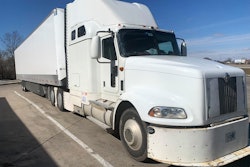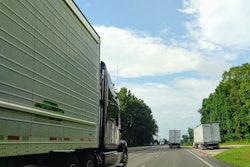I graduated high school in 1973, when the country experienced widespread fuel shortages and attendant long lines and rationing. The shock triggered immediate changes in consumer spending and, longer-term, prompted car companies to build vehicles that could achieve much greater miles per gallon. Car companies changed their marketing, too, to take advantage of the opportunity, and federal regulators began focusing on a nationwide 55-mph speed limit in a bid to conserve as much energy as possible -- that became law in 1974, and had some staying power, lasting through the next decade and more.
This and other fuel-price shocks, furthermore, began to usher in the use of fuel surcharges in trucking and other transportation modes, a practice that has only increased in the intervening years.
Recently I happened upon a book called “Visual Intelligence: Sharpen your perception, change your life.” Author Amy E. Herman offers a goal to readers -- a simple challenge to observe more, and assume less. “When we go into any situation thinking it’s going to be the same thing we’ve seen or done before,” she wrote, “we are putting up our own perceptional filter that will make any change harder.”

We all gawked earlier this year at fuel-pump pictures shared to social media that showed high costs to fill our tractors’ big tanks. Fundamentally, it’s a shock related to gross cost -- I felt the shock, too, vicariously, though I don’t have the direct responsibility of paying that bill myself anymore. Before fuel costs fell back during the Great Recession, I well recall filling up to 280 gallons of capacity at one go and at a cost greater than $1,200, with the drivers behind me asking just how I could afford that. I tried explaining the fill-up would get me nearly 2,000 miles down the road, and the rates included a significant fuel-surcharge payment. That information didn’t seem to resonate.
Though prices have fallen by some measures recently, there’s evidence the horror of high fuel persists, and for good reason. National average pricing remains well above where it was this time last year: almost 4 in 10 of poll respondents here on Overdrive this week noted simply that "prices need to come down" farther when asked about recent declines, as the chart shows.
I wondered how owners were thinking about fuel costs in relation to other costs of doing business. Last year, the fuel situation wasn't nearly the shocker it became this year, of course, but there was already plenty to be concerned about: shortages of parts, trucks, trailers, increasing costs of labor and repair times. All of these were dominating trucking business discussions.
[Related: Parts delays appear to be the rule for repairs so far this year]
I recently asked a small group of owners for their cost per mile for fuel currently. Answers varied from less than 50 cents per mile to greater than $1. Be careful when you compare your own numbers to others’. Every owner’s fuel cost is relative to just what they’re doing, and with what -- the truck owned, the trailer being pulled, the weights, the terrain, heck even the tire types, as we know. There are the owners who are ecstatic they don’t have a truck payment right now, even if their mpg might be 6 and the owner with the newer equipment and truck note is getting 8 mpg.
About those higher-mpg owners, though: Don’t forget that, depending on the truck payment amount, they’re most certainly reducing variable costs and could be adding as much as 20 to 30 cents in profit per mile to their bottom line by profiting off a fleet’s average-fuel-mileage-based surcharge. This can be a $20,000 to $30,000 profit advantage in a years’ time, based on 100,000 miles run.
Point is: when considering changes, get out of a gross-revenue mindset to focus on just what can deliver the most to the bottom line.
Will slowing your top speed driven increase your profit?
This suggestion raises the ire of many. Yet I’ve heard from many an owner recently who’s taken the slow-down tack. One I know decided to more dramatically reduce top cruise speed -- from 67 to 57 mph. This change improved mpg from 8 to a whopping 10 mpg, and the best part is the owner-op’s dedicated freight and lanes allowed him the time to do it without losing a single load.
It’s not possible for everyone, I know, given the variability in freight/lanes for so many out there, yet there’s plenty we can all do. A few years ago, I described how I learned as an owner the importance of what I’ll call economic efficiency. As with mileage out of gallons of fuel, I needed to squeeze every bit of profit out of each dollar invested to haul each load. The disadvantage we all come up against is the inability to drive enough miles to really dilute overhead costs, like a larger fleet can. Every owner-operator has to find the sweet spot for their own business.
Faced with high fixed and variable costs, we’re left with basically two options. Drive out the payments due with more miles and a larger 1099, or limit miles and haul higher-value loads for the week with potentially higher net profit. As noted above, additional income above cost of just 20 cents per mile can improve net by $20,000 on 100,000 annual miles.
The trucking business loves the biggest possible numbers -- there’s a reason fleets use gross revenue estimates to entice owner-ops to make the leap to their company or sign onto a truck lease-purchase. Anytime you see that, though, ask yourself (and most definitely the fleet) for what’s most important: net income, profit.
Every few weeks, in my process helping owner-operators review their numbers, we go over year-to-date, monthly and weekly profit and loss. My goal is to attempt to keep them grounded in a way that helps avoid emotional over- or under-reaction, as the case. In 2021, one of those owners had a fuel cost per mile in 2021 of $0.441 -- his current 2022 cost per mile to date was $0.672 on average, a difference of $0.231 per mile. Yet a second owner had been able to make significant adjustments -- his 2022 to date fuel cost was just $0.073 per mile higher than all of ’21.
While some owner-operators’ gross expenditures for fuel may have increased by as much as double their historical experience, don’t measure your business’ progress by gross figures alone. As with the rate confirmations for the loads you haul, complete and accurate information is more vital now and will ever be so. Prepare to make educated decisions. Dissect your information, look for opportunities for improvement, and if you need help, find that impartial third party for a clear set of eyes.
[Related: How Steve Kron took his 2001 International above 10 mpg]
Find more information related to fuel cost and business management and analysis, among a myriad other topics, in the Overdrive/ATBS-coproduced "Partners in Business" manual for new and established owner-operators, a comprehensive guide to running a small trucking business. Click here to download the newly updated 2022 edition of the Partners in Business manual free of charge.










